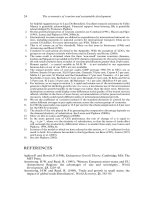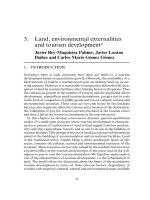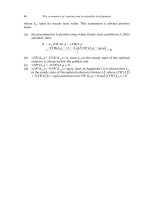THE ECONOMICS OF MONEY,BANKING, AND FINANCIAL MARKETS 113
Bạn đang xem bản rút gọn của tài liệu. Xem và tải ngay bản đầy đủ của tài liệu tại đây (55.82 KB, 1 trang )
CHAPTER 4
9. Pick five Canada bonds from the bond page of the
newspaper, and calculate the current yield. Note
when the current yield is a good approximation of
the yield to maturity.
*10. You are offered two bonds, a one-year Canada
bond with a yield to maturity of 9% and a one-year
treasury bill with a yield on a discount basis of 8.9%.
Which would you rather own?
11. If mortgage rates rise from 5% to 10% but the
expected rate of increase in housing prices rises
from 2% to 9%, are people more or less likely to buy
houses?
*12. Interest rates were lower in the mid-1980s than they
were in the late 1970s, yet many economists have
commented that real interest rates were actually
much higher in the mid-1980s than in the late 1970s.
Does this make sense? Do you think that these
economists are right?
13. You borrowed $1000 on January 1 and must repay
a total amount of $1060 exactly a year later.
a. What is the interest paid?
b. What is the interest rate?
*14. Consider a perpetuity that has a coupon of $100 per
year.
a. What is the price of the perpetuity if the yield to
maturity is 5%?
b. If the yield to maturity doubles, what will happen to the price?
*15. Suppose that the interest rate is 5%. Which of the
following statements are true and which are false?
a. $57 today is equivalent to $61 one year from
now.
Understanding Interest Rates 81
b. $5000 today is equivalent to $5250 one year
from now.
c. $37.80 one year from now is equivalent to $36
today.
CANSIM Questions
16. Get the quarterly data from 1953 to 2009 on the
three-month T-bill rate (CANSIM series V122541) and
the total consumer price index (series V41690973)
from the Textbook Resources area of the MyEconLab.
a. Calculate the (actual) annual inflation rate, using
the formula
pt * 4 + 100 + (Pt ,1 - Pt ) /Pt
b. Plot the nominal interest rate, it, and the inflation
rate, pt.
c. Assume that the expected inflation rate is the
same as the actual inflation rate (a restrictive
assumption!) and calculate the real interest rate, ir.
d. Plot the nominal and real interest rates on a
graph.
e. What is the relationship between the nominal
interest rate, i, and the real interest rate, ir, over
this period?
17. Get the monthly data from 1991 to 2009 for the interest rate on long-term Canada Real Return Bonds
(CANSIM series V122553) from the Textbook
Resources area of the MyEconLab.
a. Plot this real interest rate, ir.
b. Has the real interest rate been rising or falling
over the sample period?
c. What is the mean real interest rate over the sample period? What is its standard deviation (the
standard deviation is the square root of the variance)?
WEB EXERCISES
1. Investigate the data on interest rates available from
the Bank of Canada at www.bankofcanada.ca.
Answer the following questions.
a. What is the difference in the interest rates on 10year and 2-year bonds?
b. What is the difference in the interest rate on
long-term government of Canada bonds and
Real Return Bonds?
c. What is the difference in the interest rate on
long-term Government of Canada bonds and
corporate bonds?
2. Figure 4-1 (page 78) shows the estimated real and
nominal rates for three-month U.S. treasury bills. Go
to www.martincapital.com/main/charts.html
and click on the relevant link under Charts of
Interest Rates and Yields.
a. Compare the three-month real rate to the longterm real rate. Which is greater?
b. Compare the short-term nominal rate to the longterm nominal rate. Which appears most volatile?
Be sure to visit the MyEconLab website at www.myeconlab.com.This online
homework and tutorial system puts you in control of your own learning with
study and practice tools directly correlated to this chapter content.
On the MyEconLab website you will find the following appendix and mini-case for this chapter:
Appendix 4.1: Measuring Interest Rate Risk: Duration
Mini-Case 4.1: Interest Rates, BondYields, and Duration









